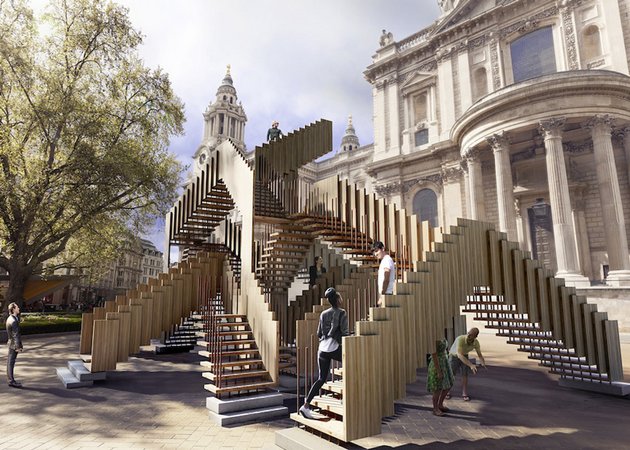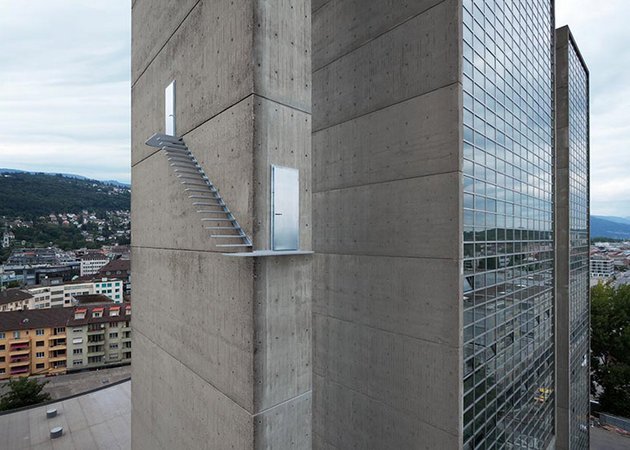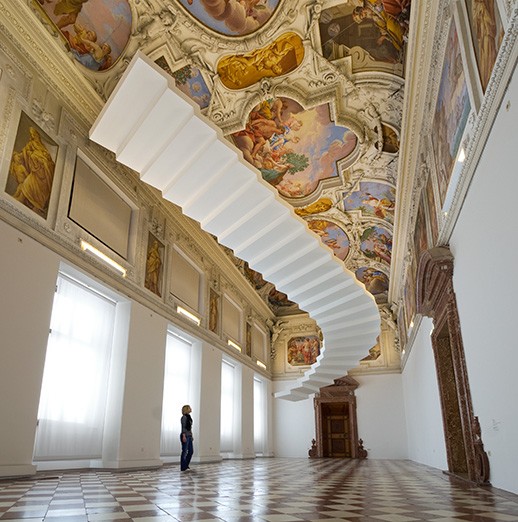You're in a hurry for work. The last thing you want to encounter is an M.C. Escher-style staircase, leading you upside-down, back-to-front and on the straight-to-nowhere. It’s unlikely that you would ever reach work given these labyrinthine conditions. Yet architecture firm dRMM have unveiled plans for an Escher-style staircase outside St Paul’s Cathedral in London as part of the London Design Festival 2013.
You probably won't be using it to get to work, but the multitudes of commuters who will pass i daily will perhaps be a little hypnotised by its irregular kaleidoscopic angles and nightmarescape geometrics. The structure, aptly named ‘Endless Stair’, aims to create a disorientating physical as well as visual experience of perspective and space. It frustratingly leads you back to square one, despite the visual illusion of progression and the very real experience of physical movement. dRMM co-founder Alex de Rijke has described it as “a three-dimensional exercise in composition, structure and scale and as both a marker and meeting place”.

The complex configuration comprises 44 cubic metres of tulipwood (a sustainable and lightweight hardwood). Visitors will be encouraged to climb the staircase and use it as a viewing tower, looking towards the Thames and Tate Britain.
Located directly beside St Paul's Cathedral and in the heart of London's City district, Endless Stair hopes to present a starkly playful contrast to the surrounding jungle of religious and corporate glass and stone. A game of perception and circulation, the structure veers towards the absurdist, or at least the surreal. Escher himself did not have a mathematical education, and his sketches are inspired more by abstracts concepts such as impossibility and eternity, rather than practical architectural designs.

dRMM are not the only creative collective spiralling towards fame, if you’ll excuse the unavoidable pun. Artists Lang/Baumann have installed a series of staircases called 'Beautiful Steps’ across various locations. Their precarious ‘Beautiful Steps #2’, installed on the side of the congress building in Switzerland, add to the building’s optical illusion. The building itself appears larger than it actually is, because the diminutive grid of its huge glass front is not in keeping with the ceiling height of its floors. The installation of the staircase is mounted on a pillar nearly three-quarters of the way up the building: an aluminium stair leads from one fake door to another.

Similarly to ‘Endless Stair’, the installation ‘Beautiful Steps #2’ plays with an imaginary functionality, perhaps even mocking the value of functionality itself. Architecture traditionally deals with the use and creation of space on functional and aesthetic terms equally. Both ‘Endless Stair’ and ‘Beautiful Steps #2’ are more akin to art pieces than architecture, precisely because they have no practical purpose. Yet the intricacy of their structure suggests an attention to engineering that artwork does not traditionally display: the works use laws of perspective, maths and physics to create something that is purposefully functionless. Perhaps drMM and Lang/Baumann and heralding the birth of ‘architecture for architecture’s sake’.
